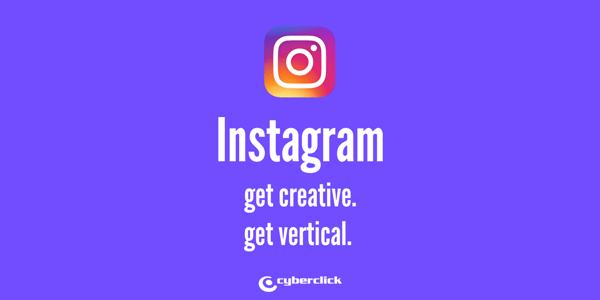Vertical videos are trending. In 2015, when Periscope and Snapchat started vouching for them, there was close to no faith in the estranged vertical format. After all, we have 120 years of history with horizontal when it comes to cinema. It’s not just cinema, it’s TVs, computers, laptops, you name it. If you think about it, it’s hard to imagine them any other way. Somehow however, over the past years, the world of mobile has started to see a change.
Mobile devices have brought with them a revolution. Humans are creatures of habit, but smartphones have brought with them their own set of habits- content consumption habits. The hand held devices have disrupted our way of getting creative, they’ve twisted our thoughts right round, by getting vertical. Marketing campaigns now start with mobile, and only later they are adapted to the remaining formats and devices. If we think about the fact that per default mobile devices are vertical and usually handled with just one hand, its logical to think the best format fit would be no other but vertical.
We’re only a few years in and this twisted way of working has arrived to vertical videos vertical they’re buzzing. True popularity is put to the test when it survives in a different habitat. Vertical videos have seen their success on snapchat, what happens when you take them to Instagram? That’s why today I`m going to analyze a few of the best creative ideas for vertical videos on this channel.

Video – Vertical – Viral
Instagram stories have seen great success for advertisers. More than 50 % of brands with an Instagram presence have created at least one story just this summer alone. It’s about discovering a new way to inspire your users, and strengthening the bond through a new level of interconnectedness.
Prior to pushing vertical videos, Instagram got together with its creative design team with the goal of sparking inspirational ideas for brands to use to their advantage.
Here are some of the creative spurs from the crew:
-
Use the progress bar at the top of the screen. This way you can create contrast in movement within your advertisement. For example, slowly start revealing a hidden image. Think of all the playroom it gives in creating the ‘before and after’ effect, or even allowing user visualization for ‘with or without’ the product.
-
Tell your story in 15 seconds. On top of making the switch from horizontal to vertical, as advertisers we have to rethink the timing of our ads. In a world with unlimited access to endless content, user patience is limited. Users who can’t be bothered to flip their phone, will not be bothered to take their time to hear you out. In its day, Vine turned us to minimalists through 6 second story telling. Technically speaking, the 15 Instagram seconds are really a luxury. Either way it will take careful planning to accurately present yourself and create a real connection.
-
Take advantage of your profile picture. Your profile picture (on the top left) is great hook for reeling in your users.
-
Emojify. With Instagram, you can add texts and emojis to your Stories. It is a simple and effective way to personalize your ads and show that you speak the same lingo your audience does.
-
Use the pause function. Many brands and advertisers have taken advantage of the option to "pause" the vertical videos of Instagram to introduce unexpected surprises and encourage the audience to interact with the contents.
-
Take advantage of the links. Instagram verified accounts can add links to their Instagram Stories, so if you’re in that position, don't miss the opportunity to link Instagram to your web traffic.
This vertical format is also available for Instagram ads. The network itself encourages its advertisers to experiment and see what option (vertical, square or horizontal) works best for the story they want to tell in their content. An interesting fact is that, according to Snapchat, vertical videos have 9 times more full visualizations on mobile phones.
6 tips for your vertical videos to succeed in Instagram
Are you convinced of the vertical ways? Before you dive in head first, allow me to review a list of tricks for your vertical videos:
-
Know your story. The most innovative and fantastic format will not do you any good if you are not sure what you want to communicate. So first of all, think about what you are going to tell, give the idea some time and write a screenplay if necessary.
-
Ask yourself who your video is directed to. Know your content, but to also hit things for your audience through format. If your audience is made up of over 40 year olds consuming content primarily on desktop computers, vertical videos may not be catering their needs.
-
Consider where you're going to publish your video. In addition to Instagram, Twitter and of course Snapchat are very appropriate sites for vertical videos.
-
Think vertically, film vertically. If your video is destined for vertical format only, consider recording it vertically from the start. If you change your mind, you also have the option of recording with a particular format and quality so that the video can be adapted to both horizontal and vertical. More details on filming in the next section.
-
Practice trial and error. As with everything in life, learn by doing, this also applies to creating vertical videos. Round up your team, have a blast, and learn by making the most typical mistakes to learn from them. My recommendation would be to start by experimenting with videos that are not going to be published, to find out what things work and which ones do not.
-
Be original. Do not limit yourself to follow the latest fashion just because. All the brands, all the stories and all the messages are unique, and it's not always a good idea to force them to fit into a certain format.

How to record vertical videos for Instagram: The technical details
1. The Camera
If you want to create exclusively vertical videos, recording vertically is an excellent idea. Today, virtually all digital cameras can record high-definition vertical videos: all you’ve got to do is give them a rotate of 90 or 270 degrees.
As you have already seen, this poses an ergonomic problem, which is that most cameras are made for horizontal use. When put in vertical, the center of gravity moves, which can make them more unstable and affect the quality of the recording (and the security of the camera!).
To minimize these problems, hold the camera firmly with two hands, close to your body and maintain a position as stable as possible. Another interesting option, especially if the camera weighs a lot, is to use a tripod.
Of course, you can also use your phone to record your vertical videos, as nowadays there are many that offer a more than adequate quality. There are many accessories in the market that will allow you to keep it in a stable position, so you won't have much trouble in this regard. One thing that may be bothersome is that the ambient sound is usually in the way. I recommend you use a separate audio track and sync it later or at least to plug in a separate microphone.
2. Composition
The vertical format flips the creative ideas of composition, so you need to think about how you're going to make it work. In particular, fast horizontal movement is difficult to reflect on vertical videos, as the reduced range of sight can make it difficult to follow or even cause dizziness for the audience. Vertical is ideal for images which project towards the horizon.
Some of the classical rules of composition will however continue to function, such as the ‘rule of thirds’. If the horizon has a lot of prominence in your video, consider framing the image so that it is above or below the middle of the image.
And finally, make sure that the important details and the text are slightly removed from the edges of the frame, to avoid the risk of being cut off by stabilizing or editing the video.
3. Thematic
If you want to change the game to vertical video, look for themes and models that benefit from this new perspective. For example, humans (as long as they are not moving horizontally), trees or mountains can be especially impressive. At the Vertical Film Festival in Australia, the first edition was held in collaboration with the Australian Climbing Festival, so many of the projected videos were related to this sport. The sky is the limit!
Also relevant to you:
Snapchat vs. Instagram: where to invest your digital marketing budget?
6 tips to increase your followers on Instagram and to grow your own brand
Perfect images for Instagram: 5 Tricks
5 things about Instagram that every marketer needs to know
By Sol Gonzales
Translated by Jessica Bubenheim
Responsable de Diseño y de la Experiencia del Usuario (UX) en Cyberclick. Se encarga de la conceptualización creativa de campañas y diseño gráfico, así como la optimización de los materiales para diferentes entornos y dispositivos. Colabora en proyectos estratégicos aportando una visión de producto centrada en el usuario.
Design and User Experience (UX) at Cyberclick. Sol is responsible for the creative conceptualization of campaigns and graphic design, as well as the optimization of materials for different environments and devices. Sol collaborates on strategic projects providing a user-centered product vision.






Leave your comment and join the conversation